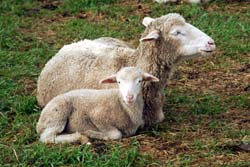Sheep
Updated: September 14, 2020

Montana ranks seventh in the nation for sheep numbers. In Montana sheep are raised primarily east of the Rocky Mountains. In 2018, sheep producers in the state raised 225,000 animals, which is about four people per sheep.
Sheep are very versatile animals. They provide wool as well as meat and milk. Most people do not drink sheep’s milk, but it is made into cheese, called Feta cheese. There are more than twenty different breeds of sheep in the United States. Some of the most popular ones in Montana are Rambouillet, Targhee, Columbia, Hampshire, Suffolk, Finn and Polypay. Some breeds are better suited for meat production, while others are better for wool. Crossbreeding is sometimes used to provide an animal well-suited for both. However, certain breeds are better adapted to the environment in some parts of the country. Sheep originated in the mountains of central Asia and looked much like goats. However, there are several differences. Sheep have fleece while goats have hair. Most goats have horns while most sheep do not. Finally, they sound different. A sheep sounds more like "baa" and a goat sounds more like "maa." However sheep and goats are both browsers. A grazer eats plants clear to the ground, while browsers would rather eat bushes and leaves. Animals like deer are also browsers.
In the spring, sheep are shorn for their wool, just like getting a haircut. Most breeds of sheep require shearing once a year. Sometimes it is done more often to keep it out of their eyes and right before lambing for cleanliness.
Shearing is a very labor intensive job. The shearer must get all the wool off in one piece with clippers. This wool is called a fleece. Many fleeces are bundled together and hauled to a wool processing plant. Later it can be made into sweaters, blankets, and other wool products. The oil (lanolin) from the wool is made into lotion.

Sheep, like cows, goats and deer are ruminants. This means they have four stomachs in one! So, they can digest grass and coarse feed that humans can’t eat and convert it into meat, wool, and other products that we use everyday.
A male sheep is called a ram, and a female sheep is called a ewe. A ewe can have one to three babies, or lambs, at a time. In Montana, lambs are born in late winter or early spring. This period of time is called lambing. The ranchers check the ewes at least every two hours all day and all night to make sure they are not having birthing problems. If a lamb does die for some reason, it is possible to give the mother another ewe’s lamb since most have more than one anyway. This way she will still have a lamb to raise.
The babies are protected from predators, like coyotes, by sheep dogs or llamas, that stay with the flock. Border collies are usually the breed of dog used for herding sheep. They go to the front of the animal rather than the heels to move them. White Pyrenesse dogs are used for guarding. They develop an attachment to the sheep and will not let anything harm them. Llamas are put in with the sheep when they are fairly young and also develop a protective instinct for the flock.
In earlier days, one person called a sheepherder would stay with the sheep day and night all year long. They lived in a covered wagon and saw other people only when supplies were brought in. The rancher would bring groceries and other necessary items once a week. Sheepherders ate mostly oatmeal porridge, bread and cheese. Their dogs ate the same. It was felt the dogs should not be fed meat, so they did not develop a taste for it and kill the sheep.
Sheep have a strong flocking instinct. They do not like to leave the group by themselves. However, they will follow another sheep that is moving away. If something threatens them they will face the danger until it gets too close and then flee as a group.
Updated: September 14, 2020

